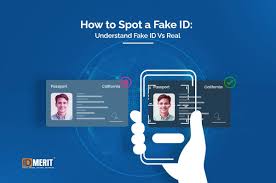fake ID technology
Introduction: The Rise of Fake ID Technology and Its Impacts
The digital age has introduced a wide range of advancements, not only improving convenience but also bringing forth new challenges. One such challenge is the proliferation of fake identification technologies, a double-edged sword that affects sectors from government security to entertainment. While traditionally associated with illegal use—such as underage drinking or fraud—fake ID technology has rapidly evolved, using sophisticated methods like artificial intelligence (AI), deep learning, and 3D printing to generate highly convincing replicas of official documents. This shift has significant implications for businesses, governments, and individuals.
Fake ID technology, like any form of innovation, has its positives and negatives. In one sense, it has created challenges for law enforcement and regulatory bodies. Yet, in another, it has spurred advancements in security measures and identity verification technologies. This article will delve deep into the world of fake ID technology, analyzing how it works, its market, and its potential future.
1. What is Fake ID Technology?
At its core, fake ID technology refers to the methods and tools used to create counterfeit identification documents. These technologies can range from traditional printing techniques to highly advanced digital tools like AI and machine learning algorithms, which produce synthetic identities that can bypass modern verification systems.
Historically, fake IDs were often physical documents such as passports, driver’s licenses, or birth certificates, which were easily counterfeited using high-quality printers and scanners. Today, the landscape has changed drastically. Modern fake IDs can be created digitally, with some advanced methods even mimicking biometric data, which poses a serious challenge for security systems that rely on fingerprinting, facial recognition, or retina scanning.
How Fake ID Technology Works
Fake IDs are produced using a variety of methods, depending on their intended use. The process often involves:
Advanced Printing Techniques: High-quality printers and scanners are used to replicate the appearance of physical documents. Holograms, watermarks, and microprinting are often included to make the counterfeit IDs appear legitimate.
Digital Manipulation: With software like Photoshop and other image editing tools, forgers can digitally alter genuine IDs or create fake ones from scratch.
Artificial Intelligence (AI): More advanced forms of fake ID technology leverage AI to create synthetic identities. These identities can be entirely fictional but still mimic real-world patterns, making them harder to detect.
3D Printing: For physical objects such as identification cards, some forgers use 3D printers to replicate complex elements like holographic seals or embossed logos.
2. Key Product Features of Fake ID Technology
Fake ID technology has evolved over time and now incorporates a host of innovative features that make counterfeit documents increasingly sophisticated. Below are some of the key features:
a. Holographic and UV Elements
High-quality fake IDs often include holograms and UV-sensitive elements that mimic those found on official documents. These features are difficult to replicate without specialized equipment, but advancements in 3D printing and holographic technology have made this easier for counterfeiters.
b. Microprinting
Genuine government-issued IDs often include microprinting, tiny text that is nearly impossible to read without magnification. Fake ID technology now has the capacity to reproduce these minute details, making the counterfeit harder to detect with the naked eye.
c. Digital Watermarking
Modern fake ID producers can incorporate digital watermarks or QR codes that, when scanned, can link to a convincing (but fraudulent) digital record. This type of feature has grown in popularity as businesses shift to digital verification methods.
d. AI-Generated Synthetic Identities
Artificial intelligence is now being used to create entirely synthetic identities—names, addresses, biometric data—that can be used to forge documents. These AI-generated personas are realistic enough to fool many verification systems, especially those that rely solely on textual or image-based information.
e. Biometric Spoofing
Biometric systems, such as fingerprint scanners or facial recognition technologies, have been a strong deterrent against fake IDs. However, new fake ID technologies have begun to develop methods to spoof biometrics, such as by creating prosthetic fingerprints or using deepfake software to simulate a real person’s face.
3. Market Analysis: The Demand and Growth of Fake ID Technology
The market for fake ID technology is multifaceted, driven by both illicit and legitimate needs. On one hand, illegal markets seek fake IDs for activities like identity fraud, illegal immigration, or age-restricted purchases. On the other hand, certain sectors—such as privacy-conscious individuals or whistleblowers—seek anonymous identification solutions that fake ID technology can provide.
a. Illicit Market
The illicit market for fake IDs is widespread, particularly among younger audiences who use them for age-restricted purchases (like alcohol or cigarettes), as well as individuals looking to bypass security checks, avoid legal penalties, or engage in fraud. This demand has fueled the development of highly advanced technologies that can fool both physical and digital security measures.
b. Legitimate and Ethical Uses
There are legitimate uses for fake ID technology, particularly in the context of privacy and security. For example, journalists working undercover in hostile environments might use fake identities to protect themselves from harm. Similarly, ethical hackers and cybersecurity firms may employ fake IDs as a means to test and improve security systems.
c. Growth Trends in Technology
According to market studies, the global market for identification and verification technologies (including both legitimate and illicit forms) is expected to grow exponentially in the coming years, driven by the need for better privacy, security, and anonymity in digital environments. While governments and businesses invest in better verification systems, the counterfeit industry is also investing in new methods to bypass them.
d. Geographic Market Analysis
Different regions experience varying degrees of demand for fake ID technology. Countries with stricter identification laws, such as the United States and parts of Europe, tend to have more sophisticated black markets for fake IDs. Meanwhile, in developing nations where formal identification systems are less robust, fake IDs are often easier to produce but may be less necessary for certain purposes.
4. Target Audience Analysis
The target audience for fake ID technology can be broadly categorized into two groups: illicit users and legitimate users. Each group has different motivations and behaviors, which influence their purchasing decisions and their interaction with the product.
a. Illicit Users
Age-Restricted Purchases: This group, typically young people (under 21 in the U.S.), uses fake IDs to gain access to age-restricted products or services, such as alcohol, tobacco, or clubs.
Identity Fraudsters: Individuals seeking to commit identity fraud or engage in illegal activities like money laundering may rely on sophisticated fake IDs to hide their true identity.
Criminal Enterprises: Organized crime groups and human traffickers often use fake IDs to facilitate their operations, including smuggling and evading law enforcement.
b. Legitimate Users
Whistleblowers and Activists: In authoritarian regimes, whistleblowers or political activists might use fake IDs to protect their identity while speaking out against the government.
Privacy Advocates: Some individuals use fake IDs for privacy reasons, especially in online spaces where they want to protect themselves from surveillance or cybercrime.
Security Firms: Ethical hackers and cybersecurity experts may use fake IDs to test the strength of security systems or verify the reliability of digital verification platforms.
5. Ethical and Legal Considerations
The production and use of fake IDs raise significant ethical and legal issues, particularly when it comes to fraud, privacy, and security. It's essential to navigate these concerns carefully.
a. Legal Implications
Using or producing fake IDs is illegal in most countries and can result in severe penalties, including fines and imprisonment. In the U.S., for example, possession of a fake ID can lead to misdemeanor or felony charges, depending on the state and the specific circumstances.
b. Ethical Considerations
While fake IDs are often associated with criminal activities, they can also be seen as a tool for privacy and anonymity, particularly in authoritarian states where dissent is suppressed. This duality makes the ethical landscape complex. For businesses, it’s essential to strike a balance between respecting privacy rights and preventing fraud.
c. Regulatory Frameworks
Governments worldwide are taking steps to combat the rise of fake ID technology, from tightening laws around identification to deploying advanced detection systems that can spot fraudulent documents. The European Union, for example, has introduced stringent rules around digital identities as part of its eIDAS regulation, which aims to secure digital transactions within the member states.
6. Combating Fake ID Technology: Industry Response
In response to the increasing sophistication of fake ID technology, businesses and governments are adopting more advanced security measures to combat fraud. These include:
a. Enhanced Biometric Systems
Many industries, including financial services and government agencies, are increasingly relying on biometric systems like facial recognition and fingerprint scanning to verify identity. These systems are far harder to spoof than traditional IDs, although they are not infallible.
b. Artificial Intelligence in Detection
Just as AI is being used to create fake IDs, it is also being used to detect them. Machine learning algorithms can identify subtle inconsistencies in fake documents that human eyes might miss, such as incorrect fonts, misaligned text, or unusual color variations.
c. Blockchain Technology
Blockchain offers a decentralized and tamper-proof way to verify identity, making it harder for counterfeiters to create fake digital IDs. By logging each step of an identity’s creation and verification on an immutable ledger, blockchain technology provides a transparent and secure method of tracking identity information.
7. Future Directions: Where is Fake ID Technology Headed?
As technology continues to advance, the arms race between fake ID producers and identity verification systems is likely to intensify. We can expect to see:
a. AI-Powered Identification Systems
Future identification systems will likely rely heavily on AI and machine learning to detect fraudulent documents. These systems will become increasingly adept at spotting even the most sophisticated fakes.
b. Biometric Authentication Advances
As biometric systems become more advanced, they will play a central role in identity verification, potentially replacing traditional forms of ID entirely.
c. Global Standardization
There is growing pressure for a global standard for identification documents and verification systems. Such a standard could make it easier to detect fakes across borders and reduce the effectiveness of international fake ID production networks.
Conclusion: Navigating the Future of Fake ID Technology
Fake ID technology is both a threat and an opportunity. While it poses significant challenges for security, it also forces industries to innovate and strengthen their defenses. As the technology continues to evolve, governments, businesses, and individuals will need to stay ahead of the curve by adopting more advanced verification systems, embracing AI and biometric technologies, and striking a balance between security and privacy.
The future of fake ID technology is uncertain, but one thing is clear: the demand for both secure identification and privacy will continue to drive innovation in this space.
 fake ID technology
fake ID technology
 ID verification loopholes
ID verification loopholes
 fake identification industry
fake identification industry
 fake Florida driver’s license
fake Florida driver’s license
 security measures
security measures
 High-quality fake ID design
High-quality fake ID design
 counterfeit ID
counterfeit ID
 vendor selection tips
vendor selection tips
